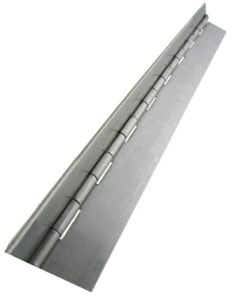
When shopping for hinges, you may come across continuous hinges. They are mechanical bearings that allow a limited angle of rotation between two objects. You can install them on doors, gates, cabinets and other objects. Continuous hinges work like most other hinges by allowing these objects to rotate. Below are five facts about continuous hinges.
#1) Features a Knuckle and Pin
They may be longer than most other hinges, but continuous hinges still feature a knuckle and pin. The knuckle is the interlocked middle section of a hinge. Both traditional hinges and continuous hinges consist of two leafs. The leafs interlock together while subsequently forming a knuckle. A pin is placed through the center of the knuckle to hold the two leafs together.
#2) Also Known as Piano Hinges
Continuous hinges are also known as piano hinges. This is because they were originally used on pianos. Pianos have a removable lid covering the keys. Lifting the lid will expose the keys so that you can play the piano. Most pianos have a single continuous hinge or “piano” hinge that connects the lid to the base of the piano.
#3) Opens to a Full 270 Degrees
Continuous hinges can open to a full 270 degrees. With such a wide angle of rotation, they are versatile and easy to use. Other hinges offer a narrower and more limited angle of rotation. Once installed, you won’t be able to pull them very far. For a wide angle of rotation, look no further than continuous hinges. Continuous hinges support up to 270 degrees of rotation, making them perfect for a variety of objects.
#4) Typically Made of Steel
Most continuous hinges are made of steel. Stainless steel continuous hinges are a popular choice for consumer and commercial applications alike. As you may know, stainless steel is an alloy of iron. If contains iron mixed with carbon, chromium and other elements. The chromium helps to protect the steel from corrosion, whereas the carbon makes the steel stronger. Regardless, stainless steel and other types of steel are commonly used in the production of continuous hinges.
#5) Available With or Without Holes
You can find continuous hinges with holes, and you can find them without holes. Holes, of course, are used for installation. After placing a continuous hinge against the objects — such as a door and a frame — you can drive fasteners through the holes. You can order continuous hinges either with or without holes.
